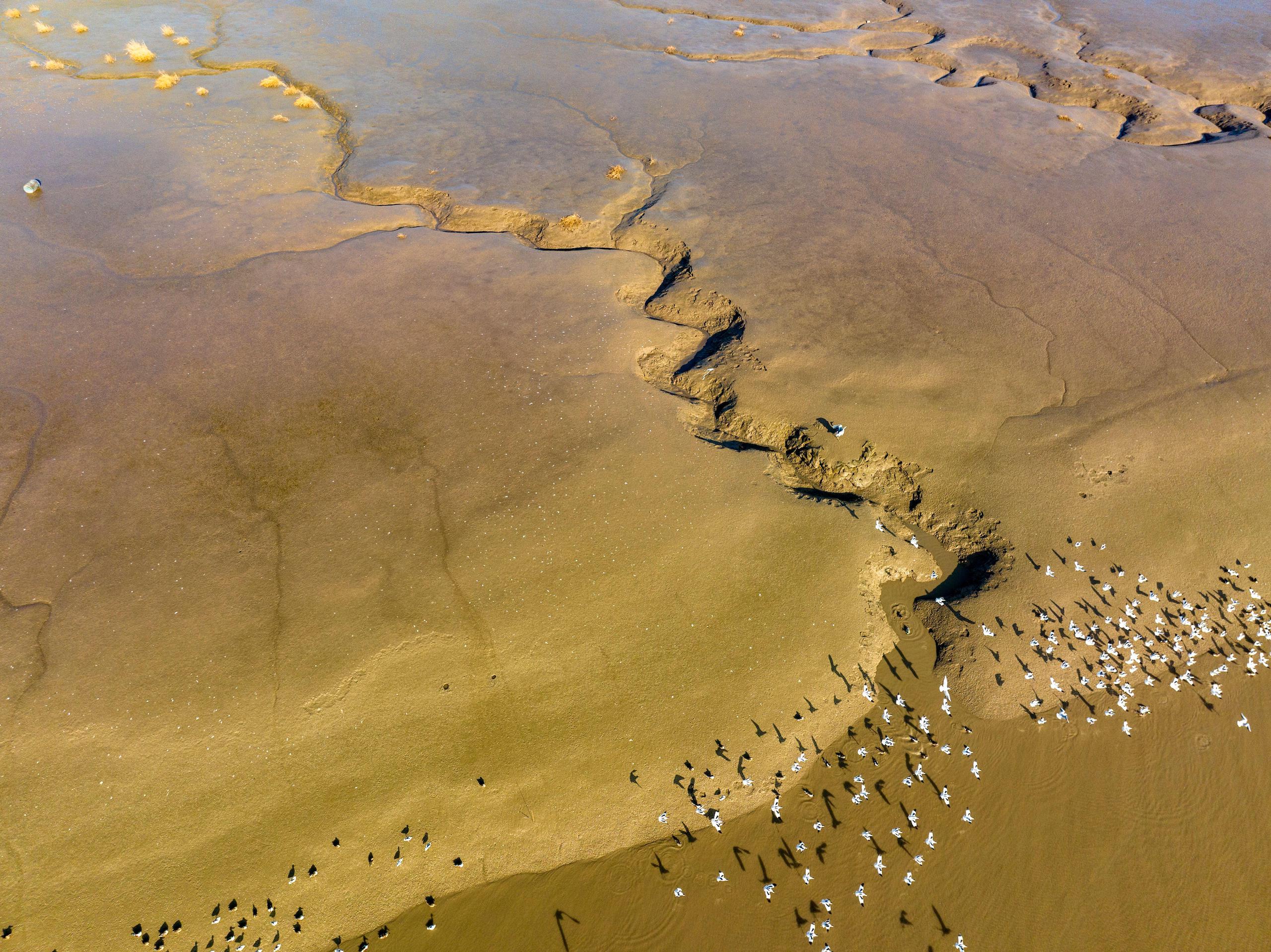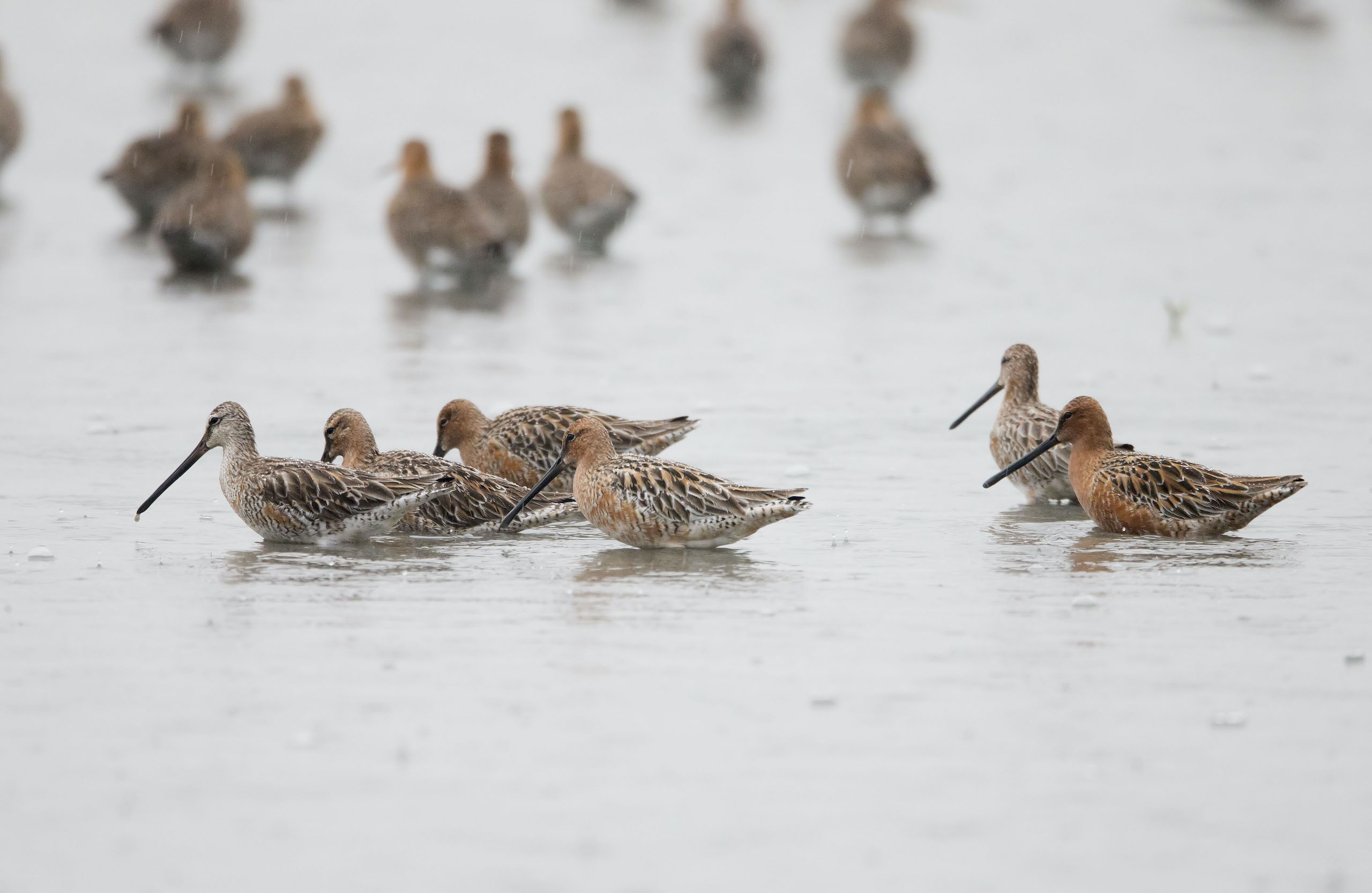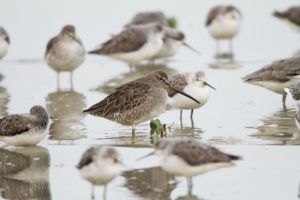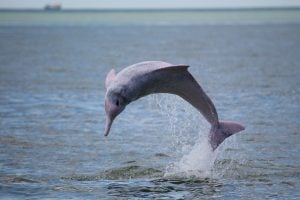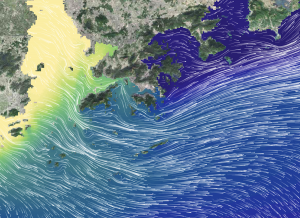The coastal wetlands on the Linhong estuary, by the Yellow Sea in Lianyungang municipality, provide an important feeding ground and stopover for waterbirds migrating between East Asia and Australia. But in 2021, an “environmental restoration” project put the mudflats at risk of erosion and destruction. They were to be turned into an artificial beach, in order to create a “Blue Bay”. In response, the environmental group Friends of Nature filed a public interest lawsuit at Nanjing Intermediate People’s Court, against both the project developer and the outfit responsible for the environmental impact assessment report.
Due to the pandemic, it was not until two years later, in May this year, that significant developments occurred in the case. The defendant, Lianyungang Gold Coast Development and Construction Ltd, said it would revise the scheme and cancel the artificial beach plan. Some of the infrastructure works had already been completed by that point, with the construction of an encircling dyke. But the revised scheme will retain the natural ebb and flow of the tide and ensure a sufficient area of mudflats on the inner side of the dyke for a waterbird habitat.
The case illustrates the misconception that environmental restoration amounts to landscaping and revegetation, and highlights the issue of conserving wetlands that lack “official status”.
Coastal wetlands are environmentally important thresholds between terrestrial and marine ecosystems. Globally, there has been a sharp drop in their area during the past half century, due to pressure from human activity and climate change. They are disappearing three times faster than forest ecosystems.
In China, coastal wetlands are the weak link in the wetland conservation system. With only 24% of them protected, they need more attention and defence.
In recent years, China has introduced a series of legal measures for protecting and managing coastal wetlands, including a system of classification and listing. Tighter control has been instituted for important wetlands by bringing them within the “ecological redlines” and nature reserve systems. Resources for conservation, however, have been largely directed at protecting “wetlands of importance” and those that fall within redline areas.
The question of how to protect other environmentally valuable wetlands remains crucial.
Environment-wrecking ‘environmental restoration’
A long shoreline stretches into the distance. The clear blue sky and azure sea blend and converge. On the golden sand, clusters of visitors are beguiled by the view as they rest or play, enjoying themselves to the full – living the “coastal dream” of Lianyungang.
Perhaps it is the “filthy, slimy” look of the mudflats, or even their “fishy stench”, that is considered ruinous to the image of a “picturesque natural harbour”. For several years now, Lianyungang has dedicated resources to developing “Lianyun New Town” and planning for the “Blue Bay” redevelopment project. This project includes building a dyke enclosing about 14 square kilometres of mudflats on the Linhong estuary, and converting tidal flats into manmade beach.
Under the banner of “environmental restoration”, the project has ended up raising part of the mudflats along the western dyke and in the inner construction area, cutting them off from tidal flushing. This has altered the character of the mudflats and undermined their ecological function as a feeding ground for waterbirds.
The mudflats, which are exposed when the tide recedes, are where land and sea interact. Flushing by the sea brings an abundance of bottom-dwelling organisms – an important source of food for migratory birds. The mudflats also provide a stopover and moulting ground for the birds, enabling them to recover their energy and build up strength for the next leg of their long flight.
The coastal wetlands of the Linhong estuary in Lianyungang provide an important habitat for a number of key national wildlife species, according to data from Spoon-billed Sandpiper in China and other organisations. This includes over 90% of the world population of the Asian dowitcher – a Class II protected waterbird. The loss of mudflats in Lianyungang will directly impact the survival prospects for that population of the species. Without this important feeding and resting stop, it will be hard for migrating birds to make it all the way across the ocean to their precious “home”.
Ma Rongzhen, an environmental public interest lawyer with Friends of Nature, says: “The ‘Blue Bay’ project is classed as an ‘Environmental Restoration Project’, but in fact it strays far from that objective. Instead, it wrecks the original intertidal ecosystem, which has an abundance of ecological functions, and it causes massive, irremediable harm to the environmental public interest.”
‘Official status’ and level of conservation
China’s wetland classification and listing system separates wetlands into three levels of importance: national, provincial, and general. Article 14 of the Wetlands Protection Law stipulates that wetlands of importance “shall be delimited within ecological protection redlines”. Thus, it provides strict protections within the framework of national spatial planning. Article 24, meanwhile, requires that, “in keeping with wetland conservation planning and wetland conservation needs, people’s governments and relevant authorities at provincial level and above, shall, in accordance with law, incorporate wetlands into national parks, nature protected areas or nature parks.” This shows the linkage between wetland conservation and development of the nature reserve system. The “level” assigned to a wetland is now closely tied to its “official protected status”.
“In Lianyungang, only the Linhong Estuary Wetland Park is a provincial-level key wetland at present, while other areas connected with the litigation case are not on the list of national- or provincial-level wetlands of importance,” explains Ma Rongzhen. This makes it difficult to obtain the protections merited by the environmental value of Lianyungang’s coastal wetlands. As general wetlands, they lack “official status”.
Having “official status” can mean a very different fate for a wetland. Take the Tiaozini mudflats in Jiangsu province. In 2011, Tiaozini, which is part of the Yancheng wetlands, was included in Jiangsu’s foreshore reclamation programme. This aimed to add to the area of agricultural land in the province to make up for arable land lost to development. As a result, 0.8 hectares of wetland was nearly turned into farmland. But a succession of policy objectives have been introduced since 2012, including protection for 30% of the natural shoreline along the Bohai Sea, provision for redlining over 53 million hectares of wetlands, and strict controls on new reclamation projects. In particular, institutional safeguards have come in since 2017 with the introduction of the Central Environmental Protection Inspectorate system, and active implementation of national environmental policy. Under the pressure of targets to be met and accountability to be provided, planned reclamation work at Tiaozini was shelved.
In 2018, the Chinese government began work on getting the migratory bird sanctuaries along the coast of the Yellow Sea and Bohai Gulf recognised as a UNESCO World Heritage site. The following year, the World Heritage Committee added Tiaozini to the list of Natural World Heritage sites.
Not all coastal wetlands have experienced as fortunate a change of circumstances as Tiaozini, however. The Lianyungang coastal wetland was originally due to be considered at this September’s session of the World Heritage Committee. But, at the end of last year, it was removed from the tentative Phase II list of sanctuaries along the Yellow Sea and Bohai coasts. This means that, in the short term, the Lianyungang coastal wetlands lose the chance of gaining protection, as a World Heritage site, under China’s system of nature reserves.
It is likely that quite a number of other environmentally valuable wetlands, similar to Lianyungang, lack official status on account of not being part of the nature reserve system or the “Key Wetlands List”. What can be done to protect wetlands such as these? How can they be spared reclamation so that their ecosystems may survive?
A ‘lifeline’ outside the nature reserve system
Last year, the “30 by 30” goal of conserving at least 30% of the world’s lands, oceans, inland waters and coastal areas by 2030, was agreed as part of the Kunming–Montreal Global Biodiversity Framework, adopted by the 15th Conference of the Parties to the Convention on Biological Diversity. In support of that goal, the framework endorses “other effective area-based conservation measures” (OECMs) as a form of conservation and sustainable management. OECM has come to be seen as a new “lifeline” for conservation in recent years, outside the system of nature reserves.
OECMs refer to conservation, governance and management measures, in areas not covered by nature reserves, used to generate long-term, positive results for ecosystems and biodiversity.
Because OECMs can encompass a broader area than traditional conservation reserves, they provide better protection for the vital ecological functions of coastal wetlands, including the ecological transition zones and migratory bird corridors that surround them. In addition, the OECM emphasis on integrated protection allows for approaches that better meet the complexity and diversity of wetland ecosystems. OECMs still have a way to go, however, before they can be fully effective in conserving coastal wetlands.
Firstly, incorporating coastal wetlands into China’s system for identifying and recognising OECMs necessitates the establishment of clear norms and standards, along with mechanisms for monitoring and assessment, to provide guidance and support for the conservation and management of coastal wetlands. Bird habitats are usually an important component of coastal wetlands, so the protection of these and the birds that use them should also be considered when coastal wetlands are brought into an OECM identification and recognition system.
Secondly, establishing an OECM system for wetland conservation requires enhanced data collection and monitoring efforts, along with comprehensive survey and assessment of ecosystems, biodiversity and human activities in wetland areas. For example, the collection, testing and evaluation of data on the populations and migration routes of birds in coastal wetlands will provide powerful scientific support for the subsequent adoption of targeted conservation measures.
In addition, establishing a data-sharing platform for cross-departmental collaboration will facilitate information-sharing and interoperability, and enable OECMs to be more efficiently managed. At the same time, wider participation by influential elements in society, and more mobilisation and transparency of societal resources, will help raise public awareness of coastal wetland conservation, bringing sustainable development for coastal wetlands.
China’s OECM efforts
Some OECM efforts are already under way in China, mainly in the form of “nature protection areas” or conservation-by-agreement arrangements. Nature protection areas cover places with a high degree of biodiversity, relatively intact natural ecosystems, or wildlife resources of significant value. They are generally designated by county or sub-county authorities, but in some cases are set up by village communities on their own initiative, or arise unprompted due to local historical and cultural factors.
Nature protection areas are not backed by force of law, unlike nature reserves. But by piloting new models for local conservation and development, they contribute to the protection of ecologically important areas. A number of provinces, including Guangxi and Jiangsu, have issued instructions for comprehensive establishment of wetland protection areas. They require municipal governments to include among their local district performance indicators the percentage of natural wetlands that are protected.
The OECM framework also includes various management tools that may be of additional assistance in conserving coastal wetlands. One example is “conservation easements”, which protect the natural value and ecological functions of the land by limiting the exercise of land use rights. The application of an easement to a titled parcel of wetland can avoid damage resulting from over-development. Another example is “mitigation banking”, under which unavoidable environmental damage due to a development project is offset by the creation, restoration or conservation of environmentally valuable natural resources. In addition, conservation easements can require mitigation bankers to collaborate and co-manage with local communities and stakeholders in order to ensure that a mitigation project is sustainable and socially accepted.
“The use of OECM in coastal wetland conservation is probably closer to the models of ‘nature protection areas’ or conservation-by-agreement, but regardless of what measures are applied, the essential point is to preserve and maintain a coastal wetland’s natural attributes as far as possible,” says Songlin Wang, chairman of the Qingdao Marine Conservation Society.
The use of OECMs, conservation easements and mitigation banking to stem the loss of wetlands, opens up a whole new range of possibilities for conservation outside the system of recognised “reserves”. The road to wetland protection and restoration is long and difficult, however. These new modes of conservation will require participation from many quarters of society if coastal municipalities, supported by joint development and governance, are to realise a wholly new coastal and ecological dream for themselves.

